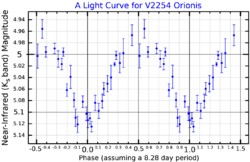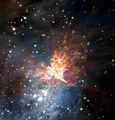Astronomy:Becklin–Neugebauer Object
| Observation data Equinox J2000.0]] (ICRS) | |
|---|---|
| Constellation | Orion |
| Right ascension | 05h 35m 14.113s[1] |
| Declination | −05° 22′ 22.73″[1] |
| Characteristics | |
| Spectral type | B[2] |
| Astrometry | |
| Distance | ~1500[3] ly |
| Details | |
| Mass | 7[2] M☉ |
| Other designations | |
| Database references | |
| SIMBAD | data |
The Becklin–Neugebauer Object (BN) is an object visible only in the infrared in the Orion molecular cloud 1 (OMC1). It was discovered in 1967 by Eric Becklin and Gerry Neugebauer during their near-infrared survey of the Orion Nebula.[4] A faint glow around the center-most stars can be observed in the visible light spectrum, especially with the aid of a telescope.
The BN Object is thought to be an intermediate-mass protostar. It was the first star detected using infrared methods and is deeply embedded within the Orion star-forming nebula, where it is invisible at optical wavelengths because the light is completely scattered or absorbed due to the high density of dusty material.
Near-infrared polarized light observations showed that the star BN is still surrounded by a circumstellar disk.[5]

Past ejection of BN
BN moves towards the northwest with respect to other stars in the Kleinmann-Low nebula. A proper motion of between 21 and 27 km/s in the northwest region and a redshift of about 11 km/s with respect to the OMC1 was measured for this star. BN is therefore considered a runaway star.[7]
It was proposed that Theta1Ori C ejected BN about 4000 years ago, but it is more likely that BN and two other runaway stars, called Source I (Src I) and Source n (Src n), were ejected from a position about 500 years ago. Source I and Source n both move in opposite directions, away from BN.[7]
With more recent VLA proper motion measurements it was realised that at least six compact sources recede from a common point: BN, source I, Orion MR (formerly source n), X, IRc23 and Zapata 11. Almost all these sources were ejected about 500 years ago.[8] The ejection of BN and source I was proposed to have occurred in the year 1475±6 (about 550 years ago).[9] IRc23 was ejected only 300 years ago.[8]
At the time of the ejection four or more protostars dynamically interacted with each other, leading to the ejection of the stars in different directions. In the classical three-body scenario, the dynamical interaction either formed a compact binary or the merger of two stars.[7] The large number of ejected stars suggest a more complex interaction, such as the interaction of a tight binary with a compact star cluster.[8]
This dynamical interaction released a large amount of energy, causing an infrared-only flare on the scale of a nova or supernova with an energy of about 1048 erg.[7]
Alternatively the explosion was not a multi-system interaction but a supernova.[10]
Explosion remnant
The remnant of the explosion is called Kleinmann-Low nebula.[11] Multi-wavelength observations and carbon monoxide (CO) observations with ALMA reveal the mostly spherical remnant of an explosion at the intersection point of the BN object and Source I. The ALMA observations revealed hundreds of CO streamers moving with up to 100 km/s. Some of these CO streamers nearly reach the shocked gas and dust observed in molecular hydrogen and iron [Fe II].[7]
Becklin's star
Becklin's star (IRC -10093) is located at 5h 35.3m / -5° 23', very near the Becklin-Neugebauer object.[12]
Gallery
The BN object (bright star in the center) in near-infrared with ESO HAWKI.
Near-infrared view of the central region of the Orion Nebula. In the center is the Trapezium cluster and the red region above contains the BN object.
Complete view of the ALMA, Gemini and VLT image showing the explosion remnant. The stars in the lower-left are the Trapezium cluster.
Part of the explosion in the eastern part with JWST NIRCam. All filters used mapped molecular hydrogen.
References
- ↑ 1.0 1.1 "NAME BN Object". SIMBAD. Centre de données astronomiques de Strasbourg. http://simbad.u-strasbg.fr/simbad/sim-basic?Ident=NAME+BN+Object.
- ↑ 2.0 2.1 Tan, Jonathan C. (20 May 2004). "The Becklin-Neugebauer Object as a Runaway B Star, Ejected 4000 Years Ago from the θ1 Orionis C System". Astrophysical Journal 607 (1): 47–50. doi:10.1086/421721. Bibcode: 2004ApJ...607L..47T. http://www.iop.org/EJ/article/1538-4357/607/1/L47/18148.web.pdf. Retrieved 2016-08-21.
- ↑ "The Becklin-Neugebauer Object: Circumstellar Disk Cradles Young Massive Star". Adaptiveoptics.org. 31 August 2005. http://www.adaptiveoptics.org/News_0805_3.html. Retrieved 2016-08-21.
- ↑ Becklin, E. E.; Neugebauer, G. (1967-02-01). "Observations of an Infrared Star in the Orion Nebula". The Astrophysical Journal 147: 799. doi:10.1086/149055. ISSN 0004-637X. Bibcode: 1967ApJ...147..799B. https://ui.adsabs.harvard.edu/abs/1967ApJ...147..799B.
- ↑ Jiang, Zhibo; Tamura, Motohide; Fukagawa, Misato; Hough, Jim; Lucas, Phil; Suto, Hiroshi; Ishii, Miki; Yang, Ji (2005-09-01). "A circumstellar disk associated with a massive protostellar object". Nature 437 (7055): 112–115. doi:10.1038/nature04012. ISSN 0028-0836. PMID 16136137. Bibcode: 2005Natur.437..112J. https://ui.adsabs.harvard.edu/abs/2005Natur.437..112J.
- ↑ Hillenbrand, Lynne A.; Carpenter, John M.; Skrutskie, M. F. (January 2001). "Periodic Photometric Variability in the Becklin-Neugebauer Object". The Astrophysical Journal 547 (1): L53–L56. doi:10.1086/318884. Bibcode: 2001ApJ...547L..53H. https://ui.adsabs.harvard.edu/abs/2001ApJ...547L..53H. Retrieved 10 February 2022.
- ↑ 7.0 7.1 7.2 7.3 7.4 Bally, John; Ginsburg, Adam; Arce, Hector; Eisner, Josh; Youngblood, Allison; Zapata, Luis; Zinnecker, Hans (2017-03-01). "The ALMA View of the OMC1 Explosion in Orion". The Astrophysical Journal 837 (1): 60. doi:10.3847/1538-4357/aa5c8b. ISSN 0004-637X. Bibcode: 2017ApJ...837...60B.
- ↑ 8.0 8.1 8.2 Rodríguez, Luis F.; Dzib, Sergio A.; Zapata, Luis; Lizano, Susana; Loinard, Laurent; Menten, Karl M.; Gómez, Laura (2020-04-01). "Proper Motions of the Radio Source Orion MR, Formerly Known as Orion n, and New Sources with Large Proper Motions in Orion BN/KL". The Astrophysical Journal 892 (2): 82. doi:10.3847/1538-4357/ab7816. ISSN 0004-637X. Bibcode: 2020ApJ...892...82R.
- ↑ Rodríguez, Luis F.; Dzib, Sergio A.; Loinard, Laurent; Zapata, Luis; Gómez, Laura; Menten, Karl M.; Lizano, Susana (2017-01-01). "The Proper Motions of the Double Radio Source n in the Orion BN/KL Region". The Astrophysical Journal 834 (2): 140. doi:10.3847/1538-4357/834/2/140. ISSN 0004-637X. Bibcode: 2017ApJ...834..140R.
- ↑ Raga, A. C.; Rivera-Ortiz, P. R.; Cantó, J.; Rodríguez-González, A.; Castellanos-Ramírez, A. (2021-11-01). "An orbital release model for the Orion BN/KL fingers". Monthly Notices of the Royal Astronomical Society 508 (1): L74–L78. doi:10.1093/mnrasl/slab072. ISSN 0035-8711. Bibcode: 2021MNRAS.508L..74R. https://ui.adsabs.harvard.edu/abs/2021MNRAS.508L..74R.
- ↑ "APOD: March 2, 1999 - The Kleinmann Low Nebula". https://apod.nasa.gov/apod/ap990302.html.
- ↑ Sky Catalogue 2000.0, Volume 2: Double Stars, Variable Stars and Nonstellar Objects - Glossary of Selected Astronomical Names, page xlv
- Becklin-Neugebauer object (Encyclopædia Britannica)
- Jiang, Zhibo; Tamura, Motohide; Fukagawa, Misato; Hough, Jim; Lucas, Phil; Suto, Hiroshi; Ishii, Miki; Yang, Ji (2005). "A circumstellar disk associated with a massive protostellar object". Nature 437 (7055): 112–115. doi:10.1038/nature04012. PMID 16136137. Bibcode: 2005Natur.437..112J.
- Plambeck, R.L.; Bolatto, A. D.; Carpenter, J. M.; Eisner, J. A.; Lamb, J. W.; Leitch, E. M.; Marrone, D. P.; Muchovej, S. J. et al. (2013). "The Ionized Circumstellar Envelopes of Orion Source I and the Becklin-Neugebauer Object". The Astrophysical Journal 765 (1): 40. doi:10.1088/0004-637X/765/1/40. Bibcode: 2013ApJ...765...40P.
- Schultz, A. S. B. (2001). "The Secret Inner Life of the Orion Nebula". Publications of the Astronomical Society of Australia 18 (1): 58–63. doi:10.1071/AS01009. Bibcode: 2001PASA...18...58S. http://www.publish.csiro.au/?act=view_file&file_id=AS01009.pdf. Retrieved 2016-08-21.
- Tan, Jonathan C. (August 28, 2008). "Astrometry of the Dynamical Ejection of the Becklin-Neugebauer Object from θ Ori C". arXiv:0807.3771 [astro-ph].
 |







